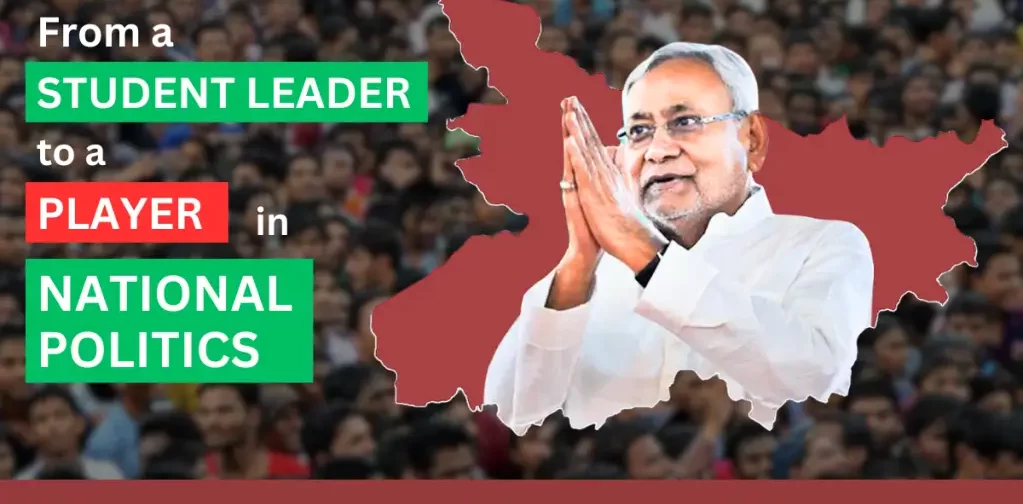
- Home
- About
- Knowledge Center
- Legislative Landscape
- Resources
- #TOGETHERFORBHARA
Bihar, Socialism, and Nitish Kumar are terms that, when used in a single statement, would not surprise anyone. Although not in a monotonous manner, this has been dominating headlines in Bihar for the last 22 years. This political stability in Bihar came on the pretext of a major political shift during the 1980s, which resulted in the locus of power shifting from Sadakat Ashram (Office of Congress) to Bhai Veer Chandra Patel Marg (Office of BJP, JDU, and RJD). This phase also created a league of socialist leaders, including Lalu Prasad, Nitish Kumar, Ram Vilas Paswan and Sharad Yadav. But among all these leaders, Nitish Kumar stands out for his enduring influence at both the state and national level. In this blog, we analyze the growth of Nitish Kumar as a leader.
Nitish Kumar, born on March 1, 1951, boasts a lengthy and distinguished political career. However, during his early years, Nitish’s political journey saw significant evolution, primarily when he operated in the shadows of prominent figures such as Lalu Yadav and George Fernandes within the Samata Party, co-founded by them in 1994. The Samata Party faced initial challenges, securing just seven seats in the 1995 elections. It was during this period that Nitish made a strategic decision, realizing that engaging in a three-way political battle wouldn’t allow for his growth.
In 1996, he aligned himself with the BJP acknowledging the importance of having a credible, non-caste-based leader with a robust political lineage by their side. Since then, in a state such as Bihar, where caste affinity vehemently affects the poll proceedings, Nitish Kumar, belonging to the Kurmi community, an OBC caste with only a 3% presence in the state, has adeptly navigated the political landscape. He initially assumed the role of Bihar’s Chief Minister for a small period in 2000 in a BJP-led alliance, but he had to resign as he could not prove his majority. However, five years later, he forged a similar coalition but dominated the proceedings and returned as Chief Minister in 2005, maintaining this position until 2014. In the following years, Nitish served as the Chief Minister of Bihar for multiple terms, most recently taking office in 2022. If we calculate the stint of Nitish Kumar as chief minister, it will sum up to 8, which is more than any Chief Minister in history.
However, during recent years, there have been some backlogs for Nitish Kumar, both as a leader as well as Chief Minister of Bihar. The reason for the former decline is his continuous pattern of switching political sides. During 10 years, Nitish Kumar changed sides 5 times, which has also dampened his performance as the Chief Minister of Bihar. Bihar, despite having relative political stability for the last 20 years, has dwindling social indicators. It has the lowest per capita income, and social and political upliftment of various communities in OBC as well as EBC is still due. 1
Even after his tumultuous years, Nitish Kumar is relevant in national politics. As in a recent Opposition alliance, he brought about unity in political parties with diverse viewpoints. He has successfully fostered better relations between the Congress and vital regional figures like Mamata Banerjee and Arvind Kejriwal, with whom the grand old party had strained relations. However, the effectiveness of Nitish Kumar’s role in the Opposition’s unity strategy will be confirmed if he can bring prominent non-BJP leaders from South India, such as KCR and Jagan Mohan Reddy, into the broader Opposition coalition for the 2024 elections. It is worth noting that the Tamil Nadu Chief Minister and DMK president, M. K. Stalin, has already been a staunch ally of the Congress.
Also, Nitish Kumar’s role in Bihar’s politics will affect the broader electoral landscape. Bihar holds considerable sway in the overall electoral arithmetic as it has a significant number of parliamentary seats. Nitish Kumar’s ability to consolidate his party’s position in the state and secure a considerable number of seats will impact the alliances and government formation at the national level.
Finally, a state of 13 crore people led by Nitish Kumar has made considerable strides in the last 15 years. However, a lot needs to be done as it still lags way behind the major developed states of India. Also, Nitish Kumar, with all his shortcomings, has been a major political force and has ensured law and order in Bihar, once prone to violence and constant breaches. His contemporary relevance is also growing as a prominent leader of the I.N.D.I.A. alliance. Hence, as the elections of 2024 are approaching, Nitish Kumar as a leader is still a mystery for various political pundits.
